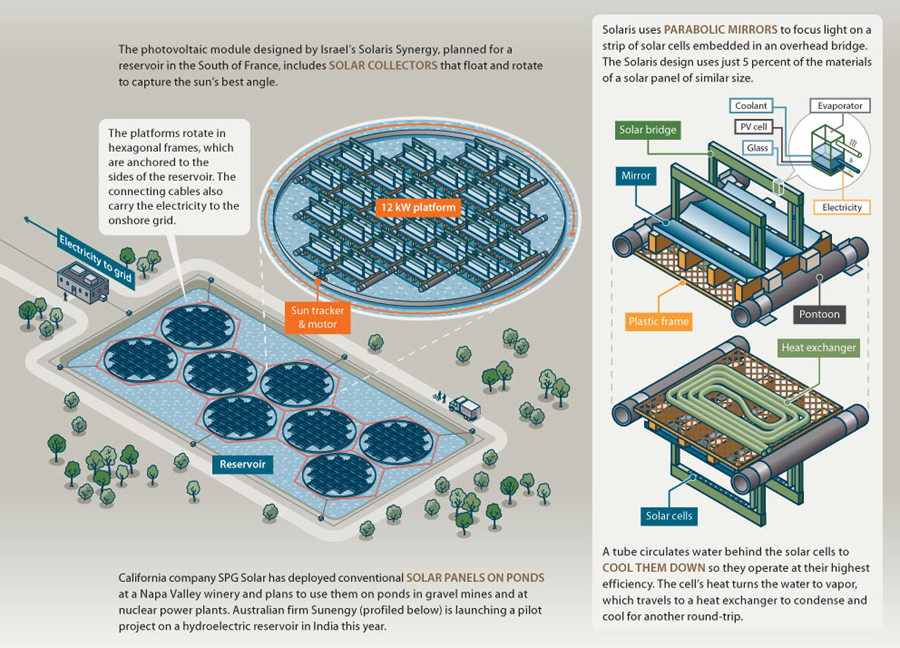sierraclub.org - sierra magazine - sept/oct 2011 - innovate: solar flotilla
Around the world, thousands of square miles of "industrial water"—cooling ponds, reservoirs, irrigation channels, and aqueducts—lose precious acre-feet as they evaporate in the hot sun. Why not slow the evaporation and create electricity by launching a flotilla of solar panels? As the warning label on any blow-dryer will tell you, water and electronics have a difficult relationship. But the advantages of "floatovoltaics" are compelling: Land is expensive, while large bodies of water, for the most part, just sit there unused. Farms, wastewater districts, and power plants can save water, reduce algae growth, and generate extra wattage by adding photovoltaics.

Infographic: Brian Kaas
HERE COMES THE SUN, THE REMIX
 Phil Connor first realized the power of solar panels in 1963 at the age of 13. He found one at a military-surplus store in Sydney, hooked the five-inch wafer to his transistor radio, and listened to a new band called the Beatles. As a young man, he wondered whether such a device could help lift the dreaded cloud of coal smoke that then hung over Australia's biggest city. His college degrees in electrical engineering and computer science were set aside when he devoted himself to yoga. But he continued his experiments with sun energy. At an ashram outside Sydney, he constructed a giant hexagonal mirror called a heliostat, which almost burned down a nearby stable when it was incorrectly aimed.
Phil Connor first realized the power of solar panels in 1963 at the age of 13. He found one at a military-surplus store in Sydney, hooked the five-inch wafer to his transistor radio, and listened to a new band called the Beatles. As a young man, he wondered whether such a device could help lift the dreaded cloud of coal smoke that then hung over Australia's biggest city. His college degrees in electrical engineering and computer science were set aside when he devoted himself to yoga. But he continued his experiments with sun energy. At an ashram outside Sydney, he constructed a giant hexagonal mirror called a heliostat, which almost burned down a nearby stable when it was incorrectly aimed.
In 2005, Connor cofounded Sunengy after developing an array of magnifying lenses that focus sunlight on photovoltaic solar cells, all mounted on a grid of floating plastic pipes. He programmed the lenses to track the sun and to automatically submerge in strong winds. This year the Tata Group, India's largest conglomerate, took an equity stake in Sunengy and will test the concept at a dam near Mumbai.
Dams are ideal for floating solar systems, Connor argues. He says that if his arrays were deployed on 1 percent of India's contained freshwater area, they could generate enough power to offset the electricity from 15 coal-fired power plants—and abate the pollution that hovers over cities like Delhi and Mumbai. "Right now," Connor says with Aussie bluntness, "is the time to provide them with the technology that will prevent us all from having to breathe crap." —David Ferris